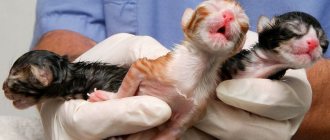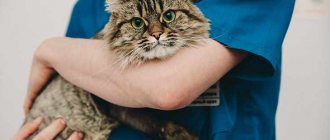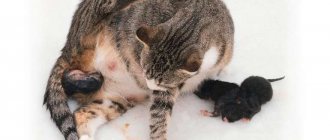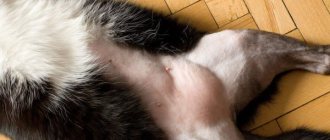Cat before birth
So, as we have already said, the first signs of impending birth are observed 7-10 days in advance.
From this period, the owner should pay special attention to his cat. If she goes for a walk outside the house, take her from the street and try not to leave her alone for a long time
You can tell that a cat is ready to give birth by the following signs:
- often lie down in a prepared box on your back;
- in the stomach you can visually notice the active movement of kittens;
- the cat begins to actively wash itself, lick the genitals, even to the point of licking off all the fur under the tail;
- a day before giving birth, she is constantly in the birth box, from where she comes out to drink water or milk;
- does not eat anything on the last day before giving birth;
- The animal's genitals become noticeably swollen, and redness of the nipples and skin under the tail is also observed.
Have you noticed these signs in your cat? Then you no longer have to wonder how long it will take for her to give birth. Here everything is already extremely clear - childbirth can take place at any minute within the next 24 hours! Be prepared for this process and purchase everything you need in advance in case complications arise during labor.
How can you tell if your cat has started giving birth? Before giving birth, a mucus plug comes out of the cat’s genitals, then the birth process begins, during which the cat can meow loudly and pitifully. At this moment, the owner should be nearby and calm his pet with gentle stroking and kind words of support.
To make it easier for you to navigate this difficult matter, consult in advance with a veterinarian who will answer all your questions in detail. Childbirth can happen differently for each animal.
For example, ordinary cats that do not have pedigree roots often give birth on their own. The owner may not even notice this process and see already born kittens affectionately eating their mother's milk.
It is impossible to predict how the birth will go. This depends on the individuality of the animal’s body and whether the cat has given birth before. Young individuals bearing offspring for the first time take longer than usual to give birth and often scream loudly. Due to lack of experience, such cats often try to run out of the box, which is not at all recommended.
It is also not advisable to allow rollovers and squats. In such positions, a cat can seriously harm her kittens. To eliminate such risks, the owner needs to control the birth process and prevent such positions of the animal’s body. It is better to carefully turn her on her side and gently stroke her stomach and back. This will calm the frightened mother cat a little.
Even an inexperienced owner will notice that the cat has begun to give birth. The first kitten will emerge from the genitals of the expectant mother. At this moment, the woman in labor will strain and push very hard, thereby trying to quickly push the baby to the light.
The first kitten may be in the amniotic sac, which occurs if it does not burst during birth. The cat will be able to free the baby from the bubble by carefully gnawing the shell.
If this does not happen, take the initiative and free the newborn from the bladder using sterile scissors. When cutting the shell, be extremely careful and attentive so as not to harm the kitten.
How can you tell if your cat is no longer giving birth? The frequency of birth of each kitten is 15-40 minutes. This means that you won’t have to expect a quick birth. After the kitten is born, the placenta emerges from the genitals, which she must eat. This will allow the woman in labor to quickly realize motherhood and speed up the lactation process.
As a rule, the owner does not have to persuade the cat; it eats the placenta by force of natural instinct.
After the placenta is delivered, you can understand that she gave birth to all the kittens and has already finished giving birth. It is very good if the birth was successful for both the mother cat and her offspring. But sometimes complications occur, which we will now talk about!
How can you tell when labor is starting?
You can understand that a cat has begun to give birth by such a main sign as the appearance of contractions. They begin several hours before the event and gradually intensify so that they can be seen without palpation. When contractions begin, the woman in labor should be taken to a place prepared in advance and calmed down.
Further, the following signs indicate that labor has begun:
- lowering of the abdomen;
- increased urination;
- mucus secretion;
- breaking of water;
- rapid breathing.
Childbirth
First signs of labor
How a cat behaves before giving birth can be understood from its behavior. The very first signs are the removal of the animal’s plug. It is called a traffic jam in a figurative sense. It is a natural beige-pinkish lubricant that comes out of the genital opening. In this way, the body clears the path for the animal’s fetuses to exit.
The surest sign is that your water is breaking. Therefore, the animal must be in a place prepared for lambing so as not to stain the sterile areas of the apartments. To prevent the cat or litter from being in danger, the area designated for cat birth should be fenced off. For example, you can take a spacious box and put disposable sheets inside.
Newborn kittens
Labor can be considered to have begun when the genital opening opens and the kittens are gradually born. The last kittens (1-2) may be born slowly. That is, there is no need to rush if it seems that lambing is already over.
Can there be false births?
Can a cat have false contractions? Can and should be present for facilitated real childbirth. False contractions begin several hours before real labor. Contractions are spasms of the uterine walls that cause the kittens to turn over in preparation for lambing. This is an absolutely normal phenomenon that prepares not only the animal, but also the owner. After false contractions, it is necessary to monitor the cat’s behavior; you should not allow activity, although the animal is unlikely to get out of its bed.
Possible complications are milk fever or eclampsia. It may not occur during the first birth, but during the second and subsequent births it may appear. But if it happened the first time, then you should expect it to happen again next time. Does a cat always have false contractions? No, but in most cases they happen. The absence of false labor can aggravate the situation. During false contractions and real lambing, the owner can consult a veterinarian by telephone. And in order to relieve himself of the difficult responsibility of delivering a baby, he can give the animal to the clinic so that professionals can deliver the baby. False contractions last on average 1.5 hours, and real labor lasts up to 4-5 hours.
Harbingers of imminent birth
On the day the cat gives birth, you can observe signs of labor in the cat:
- No appetite. The cat is limited to water or milk, and prefers liquid dishes (broth, for example) from food. This is the very first sign that the body is preparing for lambing.
- The female spends all her time in the place she has chosen for childbirth. She doesn't go out for walks at all.
- The cat will constantly lick the genital opening, where birth will take place. They do this to remove the discharge so that there is no discharge during childbirth. The presence of discharge can cause infection.
- During sleep and rest, the kittens will constantly move in the stomach. Before giving birth, they take positions that are convenient for lambing. The larger the kittens and the more of them, the more pronounced the movements will be.
- The plug comes off. Cork is a thick pinkish mixture that is released literally an hour and a half before lambing.
- The nipples swell and colostrum is released. This can be checked by gently pressing on the nipple. It will come out with a white mixture.
- About 5 hours before the real birth, false contractions appear, the cat becomes hunched over, as if preparing a comfortable position before lambing. This is one way to understand contractions in a cat. False contractions are needed to prepare kittens for birth. At the same time, the uterus does not open, the cat behaves restlessly.
- The waters break about an hour before lambing; in primiparous cats, they may break with the birth of the first kitten.
False contractions
All of the above symptoms will help to accurately determine imminent labor. Childbirth must be monitored. It is better to prepare the place and sterile unnecessary rags in advance. For example, you can buy several disposable diapers at the pharmacy.
Signs of the onset of labor in a furry beauty and help during the process
If there is a pregnant furry beauty in the house, then the loving owner is looking forward to the birth of the babies. How to understand that a cat is giving birth, so as not to miss this, although natural, but such an exciting moment? Awareness will allow you to properly prepare and competently provide assistance if necessary.
Childbirth in cats is a natural process and most often occurs without any outside help. However, situations arise when the owner’s intervention is still necessary: the animal’s first birth, low maternal instinct, labor complications. It is important for the owner to know and understand in a timely manner that the cat will give birth soon. This will allow you to prepare for the upcoming event.
Be sure to ensure that you have the following items and things:
- disposable baby diapers (unscented);
- sterile surgical gloves;
- clean, ironed pieces of fabric;
- scissors with rounded ends;
- catgut thread (can be purchased at a veterinary pharmacy);
- antiseptics (solution of brilliant green, potassium permanganate, hydrogen peroxide, chlorhexidine, sterile petroleum jelly);
In addition to preparing the necessary equipment, you must first agree with a veterinarian to provide assistance to the animal in the event of a pathological birth.
If Murka appeared in the house for the purpose of breeding kittens, the owners will have to be puzzled by information. It is advisable to clearly know the first signs of the onset of labor in a cat, so as not to miss the birth of furry offspring.
As soon as it becomes known that the cat is expecting kittens, the owners themselves need to prepare mentally, preparing the mother in labor at the same time.
- increased affection;
- swelling of the mammary glands, redness of the nipples;
- rounding in establishing the timing of the abdomen;
- the appearance of active movements on the surface of the abdomen.
First-time cats are more emotional and excited than those who have already given birth - such individuals need to be given maximum attention and care.
Preparing the site
Preparing for childbirth refers to arranging a place for the birth of kittens, ensuring a comfortable state for the cat in terms of psychological peace.
You need to prepare 2-3 places in advance where the cat could potentially bring kittens.
It is best if it is a spacious cardboard box with the bottom lined with something soft and covered with a moisture-absorbing medical diaper on top.
This is done in advance so that the animal has time to visit all the places and make a choice where it is more comfortable. This also eliminates the birth of babies in undesirable places.
All selected places must be dark, isolated, and free from drafts.
Precursors of labor in primiparous cats usually begin earlier than in those who have already given birth. Therefore, if the pet is young and has not given birth to kittens, there is no need to panic if the prenatal condition changes; it is likely that there is still some time before giving birth.
From the point of view of feline physiology, the following signs of beginning labor are distinguished:
- within 1-3 days, the cat’s body temperature drops to an average of 37°C;
- within 1-2 days, the external genitalia become red and slightly swollen, and begin to constantly lick themselves. Mucous-pink discharge may appear without a pungent odor - sometimes it seems that the cat is licking the genitals without stopping;
- activity decreases, apathy appears;
- the mammary glands visually noticeably swell, the local temperature rises noticeably (the abdomen becomes hot, but there are no signs of illness);
- the appearance of colostrum in the nipples - if you press the nipple a little, a white, barely yellowish liquid appears;
- she drinks water as usual, her appetite is preserved, but she eats very little and mostly soft or liquid food;
- approximately 2 expected days before birth, active movements are observed in the abdomen, especially when the cat is sleeping. This is explained by the fact that kittens literally turn over in the womb, taking a comfortable position for birth. This continues almost until childbirth.
Harbingers of imminent birth are visual changes in the body that are observed literally a day before the kittens are born.
- the cat begins to “hump” from time to time - this is a sign of “training” contractions, which usually appear 4-8 hours before the start of delivery;
- suddenly hides, does not come out, or, on the contrary, meows purringly and does not leave the owner. By the way, the Scottish Fold is characterized by increased anxiety right before the onset of labor;
- complete lack of appetite, constant drinking;
- An attentive owner should notice the release of the mucus plug before contractions occur. It looks like a transparent clot of greenish-yellowish color with red-brown inclusions. It usually leaves 1-2 hours before the start of active labor. Don’t worry if this moment is not recorded - cats usually lick themselves vigorously before giving birth, so they can lick her unnoticed;
- at the moment the very first contractions begin, there is an increase in the active movement of the kittens in the stomach, because they need to turn their heads towards the exit (kittens are usually located in the uterus according to the rule of compactness). The contractions themselves are not visible outwardly, but active movement of the kittens occurs reflexively. This is already starting to cause inconvenience for the mother cat; she cannot find a comfortable position for childbirth - she gets up and lies down one by one because of this;
- By placing your hand on the cat's belly, you can feel the first uterine contractions. After they begin, up to 8 hours can pass before the cervix dilates (in the Scottish Fold, the period can last up to 12-20 hours);
- the discharge of amniotic fluid is a clear sign that labor is approaching; the first kitten should appear in the next 1-2 hours. The symptom is not indicative; sometimes the water breaks already at the time of the birth of the first child.
Readiness No. 1 (the first signs of labor in a cat): strong contractions, visible even without a hand on the stomach; Murka lies on his side or sits, strongly arching his back - in time from 5 to 50 minutes, and the first kitten will be born.
We invite you to familiarize yourself with the most effective drops for cats during estrus: reviews
The owner of Murka should know how labor begins in a cat - the signs of its onset and the process itself. Everything that happens is divided into 3 main stages:
- discharge of amniotic fluid;
- birth of kittens;
- “birth” of amniotic membranes.
After giving birth, the lochia disappears over the next few days - during this period the animal should not be allowed outside, because there is a high risk of infection of the genital organs.
What should owners do when the first signs of labor are noticed in a cat? Ideally, the best help would be non-interference. Nature originally intended the birth process to be unassisted.
- be present next to your pet, talk to her in a soft, calm voice. This has been proven to calm cats, but only when they have complete trust in their owner or owner;
- prohibit children and adult family members from shouting, slamming doors, or making any sudden loud sounds, so as not to frighten the woman in labor and not to disrupt the physiological mood for the birth process;
- As soon as signs of labor have been noted in your cat, protect her from any contact with other pets, if any. This can harm the process of producing kittens due to the extreme stress of the mother in labor. A cat, perceiving any animal as a mortal danger to itself and its babies, may behave inappropriately;
- make sure there is fresh air in the maternity area;
- be prepared to give her something to drink by having clean drinking water on hand;
- Consult your veterinarian first about unusual situations if the birth process suddenly goes wrong.
Many novice cat owners feel that it is quite difficult to diagnose the approach of labor at first, before the first physiological signs have appeared. Nevertheless, the behavioral characteristics of the expectant mother also speak volumes.
If during the last week of pregnancy cats tend to become detached and even a little lethargic, before they begin to give birth, they show unprecedented activity.
The pets rush around the apartment, behave restlessly, and set up a “nest”. It is very important to take care in advance of organizing a quiet and cozy corner for the woman in labor.
Otherwise, she will find a place she likes on her own, but don’t be surprised if the linen closet or other things of yours are used.
Changes in a cat’s behavior largely depend on its character: some pets become almost aggressive, while others, on the contrary, become affectionate and require constant attention.
Knowing exactly how a cat behaves before giving birth, the onset of contractions will not take you by surprise.
As the birth process approaches, it's time to pay attention to some physiological changes.
Belly shape
You can also determine the imminent onset of labor by looking at your pet’s belly.
Watch her when she sleeps: kittens are often already actively moving in their stomachs, taking a comfortable position before they are born.
This happens about two days before lambing, especially if your cat has large babies. This is why you may notice how the expectant mother's stomach drops.
Similar article: Description of the main signs of pregnancy in a cat
Nipple enlargement
A harbinger of an imminent birth is also swollen nipples in a cat. As a rule, immediately before lambing she no longer leaves her shelter. At the same time, the nipples on her stomach noticeably enlarge and turn red. You may also notice some discharge appearing. This is colostrum, which is released just before birth.
First of all, you need to find out how the cat behaves before the imminent start of lambing. However, physiological signs also need to be paid attention to. They indicate the immediate onset of contractions, which means you can complete all the important preparations and take time to be near your pet at this difficult moment for her.
For example, the cat’s rectal temperature decreases significantly and is about 36 °C, which is, in principle, normal. That is why many experts recommend that cat owners measure their pet’s temperature twice a day a few days before lambing. As soon as it has decreased, this will be a clear signal for the start of labor.
Mucus discharge
Possible problems during childbirth
In medicine, difficult births are called pathological.
The first pathology is a violation of the position of kittens before birth. Presentation can provoke birth injuries and pathologies in the future. This is preceded by a lack of calcium, as the cause of asynchronous contractions of the uterine muscles.
This pathology can occur during contractions (first stage), then when the body begins to push out the fetus (second stage), and when the kitten emerges from the genital opening (third and final stage). The animal may hiss and scream loudly.
Note! In purebred cats (Bengal, Fold, British, Scottish, and so on), problems and pathologies are more common than in outbred cats. Therefore, veterinarians strongly recommend seeking regular diagnostics.
And during pregnancy, a specialist will tell you whether pathology should be expected and what kind. Obstetrics may be required.
The second pathology is more related to the cat itself. If the postpartum membranes do not come out during childbirth, they will cause apathy and a bad mood for the cat. The consequence of this will be refusal to care for children, bad mood, lack of appetite and brown discharge. True, for Thai and Sphynx cats, discharge and licking are not always a symptom, because the nature of the animal differs from simpler cats (British or Scottish, for example).
Obesity
These are just 2 of the most common pathologies; they can be caused by poor health, obesity, large fetuses and dozens of other reasons. As a rule, most pathologies can be detected by ultrasound.
Video
What to do if there are complications during childbirth in a cat?
If you notice any deviations from the normal course of labor, the cat should be taken to a veterinary clinic as soon as possible. Due to the temperamental characteristics of cats, almost all cases of dystocia (impaired labor) associated with mechanical causes end in caesarean section. The fetus, located in the birth canal and unable to come out, experiences acute oxygen starvation, so a cesarean section in such a case must be performed as quickly as possible.
Postpartum problems
Childbirth is behind us, but the owner must remain vigilant - the cat may develop new problems. The table shows the most common ones and ways to solve them.
Problem What to do
The cat refuses to eat
Immediately after giving birth, the cat may not ask for food for up to 6 or more hours due to the afterbirth eaten. If you fast for more than a day, you can give her low-fat broth; it contains extractive substances that stimulate the digestive activity of enzymes and the functioning of the gastrointestinal tract. If you have an intestinal disorder (may occur due to a large amount of afterbirth eaten), you need to give the pussy sorbents. When the mother's condition stabilizes, she will have an appetite.
It is important that she drinks water while refusing food.
The animal does not visit the litter box
In the first four days after giving birth, the cat may not want to go to the toilet. This is a normal phenomenon associated with the formation of milk and the restoration of internal organs, which requires a lot of fluid.
There is a discharge mixed with blood
If the volume is small, the cat’s discharge within two days after birth is considered normal and goes away on its own
You need to sound the alarm if the discharge has a pronounced scarlet color, lasts more than two days, or intensifies. This may be a sign of internal uterine bleeding or the presence of serious tissue ruptures. The cat should be taken to a veterinarian immediately.
A woman in labor has no milk
There can be many reasons for this phenomenon - from the cat’s stressful state to internal endocrine disorders. It is important to provide the new mother with complete peace: care should not be excessive. There is no need to move the box with the family to a new place or pick up the kittens. It is necessary to ensure that they are not disturbed by other pets or children. If bowls of food and drink, as well as a tray, are located far from the place where the cat and kittens are located, the pet may worry about the cubs, leaving when necessary. In addition, for a cat to have a sufficient amount of milk, its diet must include dairy and fermented milk products and water.
All that's left is the belly
First of all, it is necessary to exclude the possibility of the presence of a kitten in the uterus, while a dead fetus poses a great danger. You can independently determine its presence by palpation, but it is better to go to the clinic and do an ultrasound. In the absence of a fetus, the cause of the abdomen may be intestinal disorders, helminths, or difficulty with defecation.
An empty bubble came out
The amniotic sac may rupture as the kitten passes through the birth canal, or the cub may be born in it. In some cases, the membranes are expelled before the kitten is born. You can't let the cat tear it apart before the baby arrives. An emerging bladder without a fetus after delivery is not considered a pathology and does not pose a danger to the animal - it is a physiological feature.
Signs of eclampsia appeared
Eclampsia is a phenomenon based on calcium deficiency in the cat’s body. Symptoms: increased salivation, poor coordination of movements, anxiety, increased body temperature, convulsive muscle contractions. This condition leads to the death of the animal, so at the slightest sign you need to urgently take the cat to the clinic. A preventive measure is to take calcium-containing products during the period of gestation and feeding of kittens.
Complications during childbirth in cats
The saying “only cats give birth quickly” is usually true. But even in cats, the course of labor can be difficult for various reasons:
- Some cats, due to poor health or a violation of the parental instinct, completely ignore the newborn and in this case, removal of the membranes, cleansing the oral cavity of amniotic fluid, cutting and tying the umbilical cord must be carried out by the owners.
- Prolonged labor. If the expulsion phase is prolonged (the cat pushes fruitlessly for half an hour or more), a mechanical problem is most likely. This may be large fetuses, congenital narrowness of the pelvic opening in the mother, abnormal position of the fetus (for example, the fetal head thrown back, bending of the limb, transverse presentation, etc.).
- Generic weakness. Primary birth weakness can be congenital, secondary weakness is more often caused by external causes: exhaustion, systemic disease of the mother, calcium or glucose deficiency in the cat’s body. In this case, stimulation infusions can lead to successful spontaneous labor.
- Weakness of uterine contractions. The cat does not show signs of labor 60 or even 70 days after mating, or labor begins and stops completely after a short time. In case of postmaturity, it is important to monitor the viability of the fetuses, since over time the placenta, through which the kittens receive nutrients, wears out and begins to function worse, leading to intrauterine death and decomposition of the fetuses.
How does the feline birth process work?
Cats bear offspring for about 64 days, in rare cases - up to 70 days. On average, there are 3-5 kittens in a litter, but cases of the birth of eight cat cubs have been recorded. The duration of labor is influenced by several factors: age, number of fetuses, number of previous lambings, breed, diet during pregnancy. On average, the process of childbirth in cats takes from several hours to a day and a half, and includes periods of contractions, pushing and expulsion of the fetus.
The cat's first contractions may be invisible to others because they are still weak. At this time, your pet can be busy arranging the nest. As the contractions intensify, the cat may moan, meow, and its body periodically tenses in efforts. Then the cervix opens, the mucous birth plug emerges through the birth canal, followed by the first kitten.
Kittens are born “in order”, usually with a break of half an hour to 12 hours. Their birth may alternate with the expulsion of the placenta, which the cat sometimes eats. Kittens are born in the embryonic membrane (amniotic sac), the cat chews it, licks the cub, then bites the umbilical cord. The mother can begin feeding already born kittens in between contractions.
If your pet ignores the newborn kitten, the owner present at the birth will have to open the amniotic sac himself, carefully wipe the kitten and place it next to the mother. During the birthing process, your cat may need several hours of rest.
It is difficult for an inexperienced cat owner to understand whether all the kittens have already come out, or whether this is a break in childbirth. Even an ultrasound scan performed during pregnancy does not always reliably determine the exact number of fetuses. You can focus on the signs of the end of the birth process
During the birthing process, your cat may need several hours of rest. It is difficult for an inexperienced cat owner to understand whether all the kittens have already come out, or whether this is a break in childbirth. Even an ultrasound scan performed during pregnancy does not always reliably determine the exact number of fetuses. You can focus on the signs of the end of the birth process.
Contractions - stages of labor
Cat birth is usually divided into three stages: contractions, pushing, expulsion. In this case, the process of contractions is also divided into several substages:
- First, weak contractions.
- Contractions with an average interval are an active opening of the cervix.
- Final contractions turning into pushing.
Even experienced owners find it difficult to understand that a cat is having contractions at the first stage. The interval between contractions can last up to 30–40 minutes, while the pain is insignificant and the cat manages to hide it. The discharge of amniotic fluid from the birth canal also goes unnoticed; the cat actively licks the genital area. By licking, she keeps the coat dry and stimulates the birth process.
After your cat's first contractions begin, it may take 10–12 hours before the first kitten is born. In rapid labor, the cat goes from contractions to pushing in less than 1–2 hours. If contractions last more than 12 hours, labor is considered protracted and difficult.
Note! About 12 hours after the start of contractions, kittens begin to suffer from hypoxia - a lack of oxygen. If your cat does not start pushing, be sure to consult a doctor. In rare cases, prolonged labor is a hereditary factor and does not pose a threat to the life of the kittens.
After short contractions with a long interval, contractions of medium duration begin. At this time, the uterus actively contracts, pushing the kittens towards the birth canal. Pressure is constantly built up in the uterine cavity, which forces the cervix to expand. The process of dilation of the cervix is accompanied by severe pain, so the cat may behave very restlessly, scream loudly, and breathe with its mouth open.
Normal pregnancy process, stages and timing
In a healthy animal, the process of pregnancy and childbirth occurs without the need for intervention or assistance. In purebred, small, problem cats, childbirth may occur with complications. In more developed countries, there is a special profession - zooobstetrician, a specialist responsible for the favorable course of childbirth, preserving the life and health of the mother and offspring. In “our realities,” all responsibility falls on the shoulders of the owners and general veterinarians.
On average, a normal cat pregnancy lasts 60–65 days, but the period can vary by 7–10 days depending on the breed and body composition of the expectant mother. Conventionally, pregnancy is divided into 3 stages:
- Mating – 3 weeks: after mating, the cat experiences swelling of the mucous membranes of the genital tract, but this does not guarantee pregnancy. Clear signs are observed from the third week: Drowsiness, decreased appetite and activity.
- Requires affection and attention.
- Vomiting (no more than 3 times a day, no longer than 2-3 days).
- Distinct pigmentation of the mammary glands - from light to bright pink.
- An enlarged uterus, which can be detected by a veterinarian by palpation.
- 4-6 weeks: Rapid growth of the “babies” and “rounding” of the cat. By week 6, the amount of fluid in the uterus increases, and the kittens begin to make their first movements.
- Kittens can be “felt” when gently palpated.
- The cat eats and sleeps more, otherwise behaves as usual.
- 7–9 weeks: Kittens are actively moving. The movements are clearly visible to the naked eye, especially if the cat is sleeping.
- Swelling of the mammary glands, release of colostrum.
- Some cats have a whitish vaginal discharge, which is normal.
- Increased anxiety and making a “den”.
How does the stomach change during pregnancy?
20 days after conception, the nipples change color. If you have already given birth before, your nipples may change slightly. The belly grows as the kittens grow and develop. But if 1-2 kittens develop and grow in the mother’s belly, then the belly may be small until the last weeks.
Before giving birth, a cat's stomach drops. As a rule, this happens within 7 days, and the stomach takes a pear shape. This is due to the fact that the kittens are already preparing for birth, taking the necessary position for this.
It should also be noted that the expectant mother’s stomach is not soft, but hard, which means that the body is ready for labor and childbirth.
A cat in labor - what should the owner do?
In each of the 3 stages, the cat needs the owner in different ways.
If at the beginning the person is a direct support and participant, then stages 2 and 3 require only observation. You can understand which stage has begun by the behavior of the animal. The onset of labor is characterized by prolapse of the abdomen and discharge from the animal’s vagina. Vomiting or diarrhea may occur. But this rarely happens, because the body of the expectant mother will tell the pet in time to go on a hunger strike. But drinking in the form of clean, fresh water should be available around the clock.
The first stage ends with an increase in uterine contractions. The owner's help is to calm the animal. You need to talk and pet the animal.
You can tell that a cat is giving birth to her first kitten by the tension in her body. Contractions give way to pushing. In between, the cat will clean the newborn baby from the film. This period does not require the help of the owner - the woman in labor can handle it herself. If the woman in labor is indifferent (no more than 1 minute), it is necessary to help the kitten get out of her.
There can be anywhere from 5 to 60 minutes between kittens being born. You can help the cat give birth and calm down by performing a little obstetric assistance - patting the belly. This will ease the pet's suffering.
The final stage of labor will be the delivery of the placenta. The owner needs to monitor the very fact of the exit of the place. Do not be alarmed if a cat eats the placenta - this is what nature forces it to do - to remove all traces of unprotected babies.
It is impossible to calculate the duration of labor and how many kittens for the first time - it is the sum of many factors. Simple representatives of cats bring up to 8 fluffy balls in their litter. Pedigree up to 3-4 cats. It is also impossible to know in advance at what time of day labor will begin. But the pet will definitely notify its owner.
Giving birth to a cat is not as difficult as it seems. The main thing is not to overdo it. Nature itself will tell the cat what and when to do. But it cannot be ignored either. It is necessary to help a cat during childbirth. Especially if it is the first birth. All subsequent ones are much easier and faster. The pet knows what is happening to it, and the owner is already familiar with everything.
The exception is difficult childbirth. If one of the periods is prolonged, it is better to contact a veterinarian. Symptoms – the animal takes a long time, breathes frequently, and during breaks lies down exhausted. Kittens do not appear even with attempts. The baby's head is visible, but he is not born. It is highly not recommended to carry out independent manipulations without the consent of a veterinarian. This can provoke the death of the offspring and the mother in labor.
If you are completely confident that contractions are “sluggish”, a slow process, you can inject 0.2 ml of oxytocin into the thigh muscle before the doctor arrives. The doctor will determine whether labor needs to be further stimulated after a thorough examination.
What to prepare?
The first signs of labor in a cat do not come as a surprise. The responsible owner will begin preparations at least a day before labor. There are two options for delivery: at home or in a clinic under the supervision of a veterinarian. The chosen place for birth in a hospital does not require special preparation. Symptoms of contractions or the pushing themselves provoke an immediate trip to the doctor. When a cat has given birth, it is enough to ensure maximum peace and favorable conditions for the nursing pet.
Giving birth to a cat at home involves a thorough preparatory process. To know more about the course and stages, it is recommended to consult a veterinarian. The doctor makes a list of medications that may be useful and assesses the general condition of the animal. Possible medications include injections that can stimulate and speed up labor or pain-relieving injections. In addition to the medication component, it is recommended to prepare a place for childbirth at home, which will have sheets and a warm corner for the babies. Gloves are appropriate and sterilized cord threads should be prepared in advance.
Mating cats
Having noticed the cat, the cat begins expressive play. The cat's actions are focused on luring the cat, she seems to persuade him, yielding to him, but then runs away. Thus, the cat flirts with the cat. Then the cat grabs the cat by the scruff of the neck, jumps up and climbs into it.
The cat lets out a piercing scream and breaks away. She throws herself on the floor and starts rolling on the floor again. For some period of time the cat will not let the cat near her, but after a couple of minutes she will flirt with the cat again. Mating is repeated again. During the mating period, eggs are released from the ovaries of a cat.
The cat's sperm enters the cat's uterus, where it remains viable for about 4 days. The ability of the egg to fertilize is stored for up to 1.5 days.
What to feed a pregnant cat
A cat preparing for the birth of offspring should be fed high-calorie food enriched with vitamins and minerals.
In the first two weeks of pregnancy, the cat's appetite will increase, so the amount of food should be increased by 10%. The animal must be fed 4 times a day in small portions.
From the 3rd week of pregnancy, the cat's appetite is maximum. It is necessary to increase the volume of food by 50%, but in no case should she be allowed to overeat; she should be fed 5-6 times a day in fractional portions.
A cat's diet should include:
- meat (chicken, beef, turkey);
- egg yolk;
- vegetables (carrots, cabbage);
- dairy products (kefir, cottage cheese, yogurt, sour cream);
- cereals and cereals (buckwheat, rice, wheat);
- a small amount of fish.
If you feed your pet dry food, then choose food for pregnant cats, and then for nursing mothers.
To increase your cat's lactation, give her fresh nettle, but first pour boiling water over the herb so as not to burn the cat's internal organs and mouth.
Medicines, instruments and consumables
Preparing for childbirth includes providing your pet with everything necessary for childbirth:
sterile gauze wipes, cotton wool and bandages;
absorbent diapers, not scented;
a lot of rags, ironed and put in a bag (you can cut an old sheet, cutting off the protruding threads);
sterile surgical gloves, two to three pairs;
a waffle towel or a piece of fabric with similar properties (if you suddenly need to give the kitten a massage);
catgut or surgical thread for tying the umbilical cords, pieces 10-15 cm long (as soon as the first signs of labor appear, the threads should be placed in a glass of alcohol for disinfection);
small scissors with rounded tips;
children's syringe for suctioning liquid from the nose and mouth;
scales, watch, pen and notepad. A meticulously filled birth log makes the veterinarian’s work easier (it is impossible to remember all the information, even experienced breeders write down);
hydrogen peroxide, brilliant green, potassium permanganate, sterile Vaseline or boiled Vaseline oil at room temperature;
oxytocin, glucose, sulfocamphocaine, calcium gluconate, vitamin B12. All in injection ampoules, use strictly after consultation with a veterinarian;
disposable insulin and regular syringes;
ammonia, cognac (to revive a weak kitten or an impressionable owner);
bags for used materials.
“Only cats are born easily,” says a well-known proverb. And indeed: in most cases, the natural process of giving birth to kittens is relatively easy and without outside intervention. However, this does not mean at all that you need to leave things to chance - during childbirth, your pet will greatly benefit from the help of an attentive owner, who should also know what to do in case of complications. So, how to deliver a cat?
Pregnancy in cats lasts on average 2 months (63 days). The normal duration of this period is considered to be 59-70 days.
In order for the birth to take place calmly and safely, the owner of the furry mother needs to take some measures in advance:
- Arrange with your veterinarian to make a home visit if necessary. Be sure to check with him whether it is possible to receive consultations by phone.
- If the animal has health problems, consult a specialist: it may be better for her to give birth in a veterinary clinic.
- Before giving birth, arrange a place for your pet and prepare everything you need (more on this below).
- In late pregnancy, do not allow your cat to jump on high objects - with a large belly, she becomes clumsy and can easily fall.
Sterilization of a cat after birth
A cat's birth may involve complications, one of which may require a caesarean section. Of course, this is not an indicator for sterilization, but still a clear sign of a problem in the reproductive system.
It does not seem possible that a loving owner would again subject a furry creature to another painful birth or another caesarean section. In these cases, the clinic is consulted about sterilization. If a cat is sterilized during a caesarean section, then the procedure is more dangerous than the one that will be prescribed according to plan. In addition to complications from the operation, the cat may refuse to feed its offspring.
When is a cat spayed after giving birth according to plan? Usually the procedure is prescribed at the end of lactation, that is, 2.5-3 months after the birth of kittens. The kittens are isolated, or a blanket is put on the cat - milk should stop forming.
The veterinarian will advise which method of sterilization is most suitable for the cat who gave birth.
How to prepare for childbirth?
About two to three weeks before giving birth, once again inform all members of your family that you need to handle your pregnant pet carefully and try not to disturb her again. If there are small children in the house who, due to their age, find it difficult to explain this, be sure to isolate the cat from them! Active games at such a time will probably not end too well.
Talk to your pet more often, calm and pet your cat. She will feel your care and participation, and therefore she herself will be much calmer. Your most important task is to be sure to accustom the animal to the basket or box in which, in your opinion, she should give birth.
Remember that the more time you spend training your cat to use the birthing basket, the less likely she is to choose to give birth on your bed. However, this possibility cannot be completely ruled out: always be on guard, unless, of course, you want to pull kittens out from under the bed or bathtub (or from even more exotic places that your cat likes).











